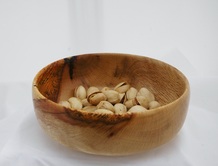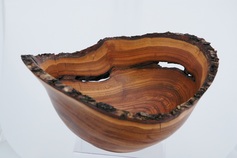Utility bowls for foods

Utility bowls and utensils are designed and finished to be used as a vessel for food to serve almost anything such as pasta, salad, vegetables, potatoes, popcorn, and fruit. These bowls are finished with a food safe combination of walnut oil and natural beeswax. After use, simply hand wash with warm water and mild soap, then let it air dry. Only three no-no’s … do not soak it in water, do not put it into the dishwasher, and please, no microwave. [I guess we could add a fourth and say no oven or stove, but we’ll assume you figure that one out.] Occasionally if it starts looking dry, recondition by rubbing in a little walnut or mineral oil. Over time the handling, using, and occasional re-oiling, will cause the patina to improve and take on an even more pleasing state. With proper care, such a bowl will last for generations.
Gallery bowls and turnings

In general gallery pieces, are not intended as primary vessels for food service. Any turning that has piercings, holes, voids, natural edge bark with crevices, etc. should be treated with more care than utility class turnings. Such vessels can be used to hold dry foods or fruit but foods that would collect in the crevices should be avoided. Also obviously, delicate pieces should be treated accordingly.
Two notes:
- Water and wood. Oil and wax finishes generally can withstand being briefly immersed (not soaked) in water and then wiped and air dried. Other finishes such as varnish, polyurethane, and lacquer are not in themselves harmed by being briefly wet; however, if water gets into the wood beneath the finish it can cause bubbling and lift off the finish. It is difficult to repair such damage on a turning. Accordingly, for a bowl with natural edge bark, piercings, holes cracks, crevices, voids, it is generally the best practice just to wipe with a damp or wrung out wet cloth but not immerse the bowl in water.
- "Food safe finishes". Virtually all finishes for wood products, once they are fully cured and dried, are safe to come in contact with food. Walnut and beeswax finishes as used in my utility pieces are ready for contact immediately after being applied. Other finishes typically having drying agents in them that generally need longer to bind to the wood and finish and become inert. Those finishes generally should get 6-12 weeks of curing before one can be assured they are safe to be placed in direct contact to contain food. Danish oils, lacquers, varnishes, etc. are in this latter category.